(2 PM – promoted by TheMomCat)
Burning the Midnight Oil for Living Energy Independence
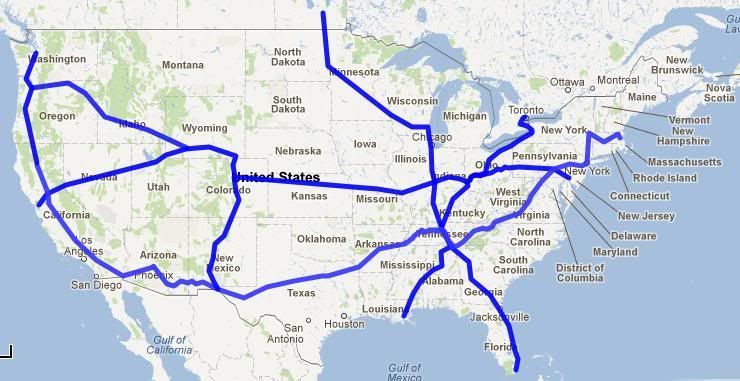 Steel Interstate (noun): A Network of Electrified Heavy and Rapid Rail corridors that will allow the United States to remain a sovereign national economy.
Steel Interstate (noun): A Network of Electrified Heavy and Rapid Rail corridors that will allow the United States to remain a sovereign national economy.
Integrated into the Steel Interstates are Electricity Superhighways to connect Renewable Energy Resource areas to each other, to substantially increase the stability of the available Renewable Energy Supply, and to Energy Consumers, to ensure that no rich Renewable Electricity Resource goes untapped for lack of access to a electricity markets.
This is something that the United States should do. Depending on the twists and turns of international energy markets in the coming decades, it may be something the United States must do, to remain a coherent national economy.
If the efforts of Big Oil and Big Coal are successful, it is the kind of thing that America will not be able to do.
Yet, I believe it is something that the United States actually can do.
The Millenium Institute National Rail Electrification Program
One cornerstone of the Steel Interstate proposal is the work of David Drake and the Millennium Institute on the electrification(pdf) of the roughly 20% of the national rail network that carried roughly 80% of the nation’s rail traffic . The work of David Drake, A. M. Bassi, E. L. Tennyson, and H. R. Herren indicates:
Several policy scenarios were modeled with constrained oil supply using Millennium Institute’s T21-USA model. The most positive result by every significant metric (GDP, greenhouse gas emissions, oil used) came from the combination of the two most environmentally positive policies: a massive push for electrified rail transportation (inter-city railroads and Urban Rail) coupled with a massive push for renewable energy, to be completed by 2030.
With an estimated total investment of $250-500 billion in inter-city railroad lines Non-Oil Transportation could supplant most inter-city truck freight and unspecified modal share of passenger service. Up to $60 billion/year ($1.2 trillion over 20 years), spent cost effectively on Urban Rail, should allow for 28% annual growth (not compounded) in urban passenger-miles on Non-Oil Transportation.
These two investments create a 11% larger GDP, only 4% increase in Greenhouse Gas Emissions and a 26% reduction in oil consumption already in 2030 versus a strictly market based reaction. Adding renewable energy improved the results to GDP +13%, GHG (-38%) and oil consumption (-22%).
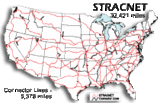 The Steel Interstates are not the entire policy package, but they are one major piece. To get an idea of the scope of the Millenium Institution Proposal, it is roughly equivalent to electrifying the Department of Defense STrategic RAil Corridor NETwork, STRACNET.
The Steel Interstates are not the entire policy package, but they are one major piece. To get an idea of the scope of the Millenium Institution Proposal, it is roughly equivalent to electrifying the Department of Defense STrategic RAil Corridor NETwork, STRACNET.
The provision of Rapid Freight Rail is a critical element of the proposal. Despite lower shipping cost by rail, the higher reliability and speed of truck shipping allows it to dominate long distance freight shipping in the United States for all except heavy bulk freight. And it is the capture of existing long haul truck freight that is the key element to the energy efficiency of the project. As noted in the Oil Drum piece:
Transferring freight from truck to electrified rail trades 17 to 21 BTUs of diesel for one BTU of electricity. Simply electrifying existing rail freight would trade 2,6 to 3 BTUs of diesel for one BTU of electricity.
The full build out of the Millenium Institute proposal is estimated at $500b.
The Steel Interstate Proposal
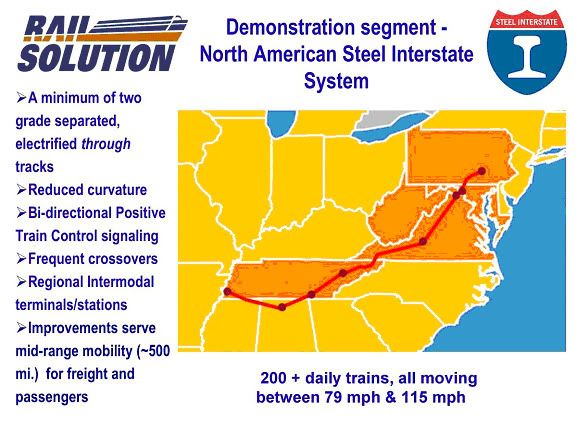 Complementing the work of David Drake and the Millenium Institute is the work of The National Steel Interstate Coalition. The National Steel Interstate Coalition started with the work of RAIL Solutions, based in western Virginia, proposing an alternative to the egregiously wasteful proposed expansion of I-81 in the form of an electrified steel interstate corridor from Harrisburg, Pennsylvania, through to the Shenandoah Valley in Virginia, and then into Tennessee.
Complementing the work of David Drake and the Millenium Institute is the work of The National Steel Interstate Coalition. The National Steel Interstate Coalition started with the work of RAIL Solutions, based in western Virginia, proposing an alternative to the egregiously wasteful proposed expansion of I-81 in the form of an electrified steel interstate corridor from Harrisburg, Pennsylvania, through to the Shenandoah Valley in Virginia, and then into Tennessee.
When I first encountered the RAIL Solutions proposed pilot corridor, it only extended to Knoxville, but for electric freight rail, the longer the run the better, since truck freight is faced with the fixed time cost of switching containers from truck to rail and back again, and rail freight is faced with the need to either switch locomotives or to acquire dual-mode locomotives, and in either case the longer run makes it worthwhile for a greater variety of freight. So the extension of the corridor through to Memphis seems natural to me.
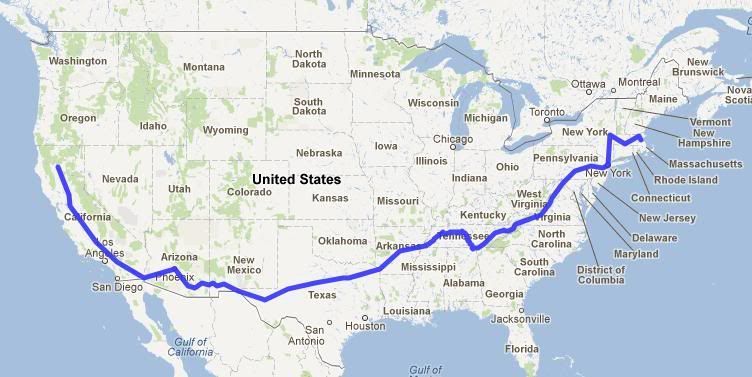 Indeed, I thought it was so natural that I extended the pilot corridor in one direction through to the Gadsden Purchase alignment to California, and in the other direction through New York to Boston along an inland route to form the Liberty Line, in my proposed foundation Steel Interstate System.
Indeed, I thought it was so natural that I extended the pilot corridor in one direction through to the Gadsden Purchase alignment to California, and in the other direction through New York to Boston along an inland route to form the Liberty Line, in my proposed foundation Steel Interstate System.
Now, there are some substantial engineering hurdles facing this line, in particular in Massachusetts where the inland rail corridor at present is a wending, winding corridor, and in Tennessee, where Chattanooga westbound is a difficult alignment challenge. So when I looked to North/South corridors, I looked to leverage the investment in this corridor with a corridor starting in Florida, and extending up to the Great Plains (and access to a major Wind Resource grid) and up to the Canadian border to connect into the Canadian transcontinental rail corridor.
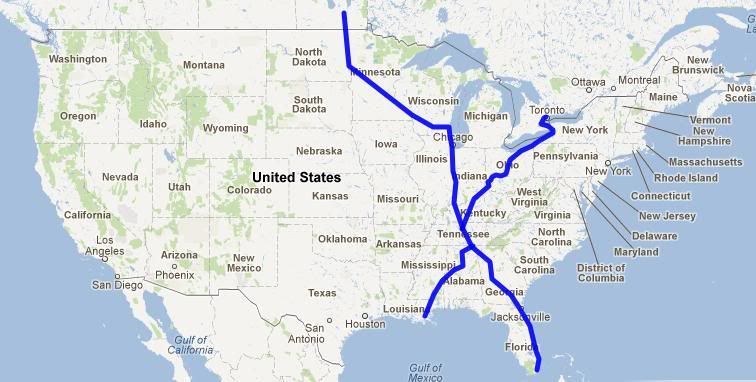 The National Line and Florida / Great Plains corridor leave broad swaths of territory between the northern and southern legs of their corridors. To fill that in, I adds a New Orleans corridor to the south, and a Louisville to Buffalo line to the north, connecting to the eastern Canadian rail network at the Niagara Falls border. So the “Heartland Line” forms an X that runs north to south in the eastern to midwestern US.
The National Line and Florida / Great Plains corridor leave broad swaths of territory between the northern and southern legs of their corridors. To fill that in, I adds a New Orleans corridor to the south, and a Louisville to Buffalo line to the north, connecting to the eastern Canadian rail network at the Niagara Falls border. So the “Heartland Line” forms an X that runs north to south in the eastern to midwestern US.
These two corridors provide ample connection the Southwest and the Northeast, but no direct connection between the Northeast and Great Lakes / Midwest, so the third Line starts in Delaware and runs through Pennsylvania to the Great Lakes States, and then through to Denver. From there it connects the central and southern Transcontinental routes with a corridor along the Front Range, the central route to California with a Cheyenne alignment to Salt Lake City and from there to Oakland via Reno, and a connection to a Pacific Northwest corridor, connecting from the Cheyenne alignment.
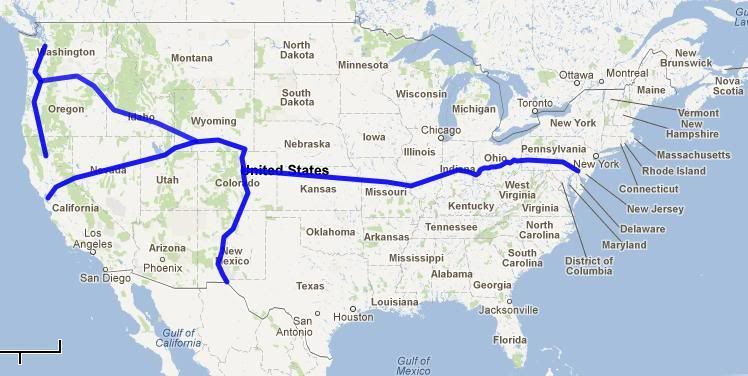 This forms the line I refer to as the National Line, and is the line that completes the foundation system.
This forms the line I refer to as the National Line, and is the line that completes the foundation system.
But Can We Build It?
The critical question, through, is whether we can build it?
The question of whether we can built it is not a question of resources. Given our high unemployment rates, we have labor resource to spare, and given our depressed capacity utilization rates, ample resources of idle productive equipment. And the project is a massive economizer in natural resources. This included energy resources, but also includes economizing on the resource of the atmosphere used as unpaid but quite expensive CO2 dump. This last comes both from the elimination of problems such as “Stranded Wind”, and also from the greater stability of “use it or lose it” resources like Wind and Solar when multiple independent resource areas are connected together.
And of course it is not a question of money, since money is a marker for the productive capacity of a national economy, and so we can afford to issue currency for such a productive investment in expanding our nation’s productive capacity.
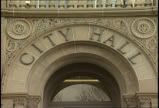 It is, of course, a question a politics. Can we build a coalition for building a Steel Interstate system with sufficient political clout to overcome the powerful and entrenched interests of Big Coal and Big Oil in retaining the status quo, no matter how suicidal it may be over the long haul for our nation’s economy?
It is, of course, a question a politics. Can we build a coalition for building a Steel Interstate system with sufficient political clout to overcome the powerful and entrenched interests of Big Coal and Big Oil in retaining the status quo, no matter how suicidal it may be over the long haul for our nation’s economy?
I am not political forecaster, so I do not know the answer to that question.
The best I know is to try, since if we do not try to succeed, we will surely fail, while if we do try, there is some chance, no matter how distant, that we can regain the national economic sovereignty that we lost in the 1970’s. It will require overcoming three decades of radical reactionary political action have been directed to ensuring our continued economic subjegation to transnational energy corporations.
We need to work out a modus operandi with the Class I freight railroad: a broad agreement on a design envelope and funding of works that will satisfy their interests as owners of the corridors that will host the large majority of the Steel Interstate systems.
We need to get candidates on the record as support a Steel Interstate system.
Manufacturers will be beneficiaries of this system, as an appreciable share part of their exposure to oil price shocks lies in the impact of oil prices on shipping costs. This system would both reduce shipping costs and insure them against substantial oil-driven increases. We need to either wedge the National Association of Manufacturers from the embrace of the national business organizations captured by the radical reactionaries, or else spearhead the establishment of an alternative National Association of Entrepreneurs that can counter the radical reactionary propaganda of NAM, the US Chamber of Commerce, and the other national business organizations captured by political partisans with interests increasingly out of line with the interests of their business membership.
With respect to the “US Chamber of Commerce”, we need to approach local, actual chambers of commerce for their support for a system of Steel Interstates.
Its not necessary to win support for the proposal from a majority of business interests. However, a broad base of support from some of the broad range of business interests who would benefit from the system is a key element to organizing a movement that can gain traction in our thoroughly corrupted political system.
And to that we need to add a progressive coalition of environmentalists, supporters of sustainable development, and organized labor.
And then more organizing and coalition building, since major policy wins against powerful, entrenched interests do not happen in a day … but, even in our first Gilded Age, progressive coalitions were able to win the Women’s Right to Vote and Direct Election of Senators, so even in the face of powerful, entrenched opposition taking full advantage of a thoroughly corrupted system, progressive change is possible.
Conclusions …
As always, the next step is not arriving at final conclusions, but rather to throw the floor open for comments. Remember that comments on any topic on Sustainable Transport are welcomed and encouraged on the Sunday Train so do not feel yourself limited to the topic at hand … though if its on another topic, make a note in your comment that you are raising another topic, so I don’t sprain my poor brain trying to work out the connection to this evening’s Sunday Train essay.
And now, as you gather your thoughts for the colloquy to follow, the opening act leaves the stage to make way for our headliners, Midnight Oil.
Midnight Oil ~ The Dead Heart (unplugged)
…
We carry in our hearts the true country
And that cannot be stolen
We follow in the steps of our ancestry
And that cannot be broken
We carry in our hearts the true country
And that cannot be stolen
We follow in the steps of our ancestry
And that cannot be brokenMining companies, Big Mountain companies
Chemical companies, Uranium companies
Get out of those companies, yeahGot more rights than people, oh yeah
More say than people, oh yeah
More say than people, oh yeah
More say than you and I, the people, yeahoh yah yah yah the dead heart
oh yah yah yah the dead heart
oh yah yah yah the dead heart, livesoh yah yah yah the dead heart
oh yah yah yah the dead heart
oh yah yah yah the dead heart, lives

1 comments
Author
… and rocked our trains down to Electric Avenue back in the 80’s, but that’s water under the bridge now …